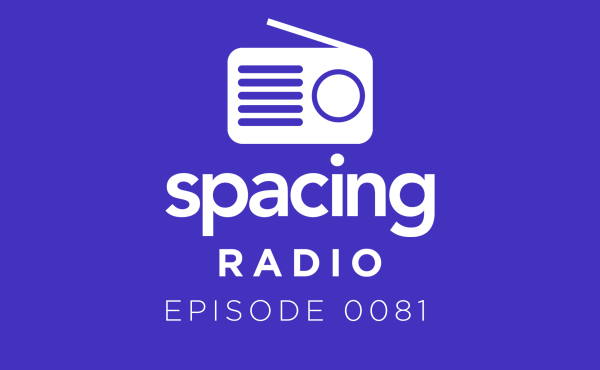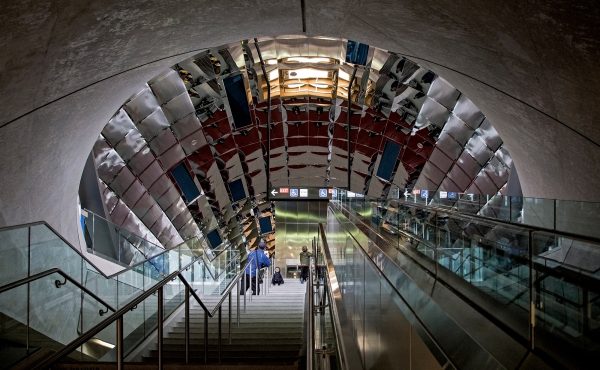

Holiday week required two trips two days in a row to Pearson’s Terminal Two via car to drop off and pick up various current and former Torontonians and their festive parcels. It will be nice when a fixed link is established to our airport and the impulse to use a car is diminished — but for now when time allows there is still a certain thrill in getting on the 401, during perhaps the only week when it isn’t insufferably slow, and negotiating all those lanes of fast moving traffic. It was a sad couple of trips though, as T2’s days are numbered. It’s your last chance to see it and the greatest-parking-garage-in-Canada attached to it.

Terminal Two was often our in-between point when traveling between Windsor and Halifax as it was the Air Canada hub. Sometimes we would switch planes there, other times get dropped off after a 3.5 hour 401 drive. It did as much to contribute to my childhood view of Toronto-as-modern-utopia as did Ontario Place or the CN Tower. It was the first place I rode on moving sidewalks (when you jumped on them they bounced a bit, like a narrow trampoline) and sat in chairs with built-in black and white TVs that operated on a quarter-by-quarter basis. Old Aeroquay 1 was more celebrated for its ’60s jet set design, but for us, Detroit’s International terminal was where we picked up relatives from Malta or Australia so T2 was the most familiar place at Pearson. Today it mostly handles Air Canada and United flights to the United States, as domestic travel goes through the new T1. Back in July when flying to California, we bestowed the “Saddest Room in Toronto” title to the U.S. Pre-Customs area at T2. Abandon all hope, ye who enter post 9-11 America.

The terminal itself is only remarkable because of it’s eternal length — it was originally a freight terminal (more about this in a Stroll column from last year) — making the low-rise parking garage stand out even more. The tiered concrete, each level having a row of plants that hid the cars inside, looked unlike anything else. During the summer it was like parking inside of a Mayan pyramid that had been consumed by the jungle, a brilliant contrast of grey concrete and vibrant green. That is, if the Mayan’s had electricity, because all the ramps in and out have guardrails that light up from within. Last week the plants were in winter hibernation, and many of the lights inside the rails were burnt out, but it still made the act of driving into a parking garage feel like docking a space shuttle.


Though there is no need to strike a Save Terminal Two Committee or chain hippies to the concrete to block the wrecking ball, this old parking garage and terminal will be missed a little. When a place this big suddenly ceases to be a place, it’s a strange thing, and leaves a bit of hole in the psychogeography of the city. Two years ago we flew out of Montreal’s Mirabel Airport during it’s dying days — it had a similar feeling of mass abandonment. You can almost hear the buildings say “I used to be somebody, I used to be a contender.”
If you visit this month, spend a little time at the arrivals platform and just watch. If you don’t get to see an overzealous GTAA employee interrogate the old lady above about how she got her airport wheelchair, you’ll watch people pace and fidget as they wait for their missed-one, then when they see each other wave then smile awkwardly for a few seconds as the arrival makes his/her their way down the ramp until they can finally hug. You will cry your own airport tears if the person you’re picking up is late enough and you get to watch a few too many of these little wonderful public-private moments.




14 comments
It will be nice when a fixed link is established to our airport and the impulse to use a car is diminished â€â€
I know there is much talk of a rail link to downtown, but I can’t see how it would make the journey much easier, save for those staying at the Royal York. I took the TTC from the airport to Cabbagetown on my last trip – 1 ticket, less than an hour, three transfers (ugh!). A fixed rail link wouldn’t cut much off of that and likely be priced at 20$, plus TTC or a cab (11$) to Union Station.
Building a rail link will likely have some negative impact on the Weston community and it’s holding up the West Rail Path project.
In the end it seems like one of those things we need in order to be “world class”, but other wise doesn’t add much value.
Yes, I guess that’s the thing, you still have to get to the link. A subway line leading to it would be good, and keep it in the TTC. The Eglinton Subway perhaps? Or maybe a spur line from Kipling — one would go to Square One, another up to the Airport.
What I like about a fixed link idea is that it runs independent of traffic concerns. It would be (more) reliable.
I made it from the Airport to Cabbagetown in Sept in the same amount of time. The Parliament Bus was waiting at Castle Frank, as was the Airport Rocket at T2. It’s nice when things fall into place on their own.
GO (not the SNC-Lavalin Blue 22) should be providing the link as an integral part of their network, with stops at Woodbine (to connect to GO Georgetown and VIA Guelph/Kitchener/Stratford/London), Weston, Bloor West (for BD, especially D) and Union. The extra stops wouldn’t add much to journey time, would help with the anger Weston residents are feeling against the Blue22 project (and improve Weston-downtown frequency overall), leveraging the entire GO-TTC system rather than just the downtown.
Using the GO network provides connection to the Lakeshore East and Stoufville via Union. A heavy rail link with a VIA stop and an improvement to the Kitchener line could be the deathknell for the 7x daily Air Canada Pearson-London, ON and soon after that the Pearson-Kingston, ON.
It’s past time we started leveraging the GO network within the 416, making it integrate fully both with TTC and with VIA to make door-to-door transit a reality.
Nice observations, Shawn. It is indeed strange when a place loses its status or usefulness and becomes no more. Though losing mythic Mirabel felt odd, the outcome of the story is a good one – after talk of making it into a mega-mall or amusement park, politicians did the right thing and gave the land back to the farmers who had to give it up for Trudeau’s dream in the first place (http://tinyurl.com/ybnhma)
Of course, the move may have been partially motivated by a sense of justice, but it cannot be denied (read the CBC article linked above) that Harper truly enjoyed taking shots at the Trudeau legacy.
MK
(fully supports blogging about airports)
EVERY major city has a rail link to the downtown. That’s where most tourists are travelling. There is supposed to be a few stops along the way, I believe: At Dundas West subway station and somewhere out near Weston. You can take the Bloor subway ($2.75) and the fixed link (possibly $15 or $20). It will take you no less time than a taxi if you’re coming from the southern part of the city.
Any kind of LRT that will cross the top of the city (along the hydro lines, like Miller suggested at one time in a Spacing issue) should link up to the airport.
Blue 22 is useless, and the NIMBY reaction in Weston in this case was well justified. A private company (SNC Lavalin, the same ones behind the Union-Pearson bid for Union that eventually sunk) was going to piggyback on GO’s track improvements and provide a $20 service to Pearson from Union. Weston residents were against it not because of the amount of trains, but the mega infrastructure to allow the Blue22 trains to race through their neighbourhoods, cutting streets off, with no benefit to locals. They have been in favour of any service that stops there, and would even accept MORE trains than Blue22 proposed for this to happen. Weston sure could use the boost a real transit service would provide.
Yes, most tourists would head downtown. But most travellers are not, and Blue22 is useless to those living north of Bloor or west of Bathurst. Yes, there were plans for a minor stop at Dundas West, but it would still not capture a huge market. And few business travellers head from work to the airport, they head from home, and would be able to expense a taxi or limo.
A taxi gets much cheaper as soon as 2 or more are in the group. Better to have a semi-local rapid transit line with stops in Weston, at Eglinton, St. Clair, etc, or as part of a decent regional rail line extending to Brampton, with a connection at Woodbine that VIA trains could also use.
Anyway, I won’t miss T2, but the garage was cool, with the lamps in the railings and the terraced look. Another terminal I found I liked is the one in Winnipeg, with its simple 1960s look, let functional. Though there are plans to build a new glass and steel box to replace that little gem.
Terminal 2’s demise has been long and the building was the most dull and clinical entrance into town but you’re right – that parking garage is cool looking and iconic and I will miss it. As for the rest of terminal, man, an airport couldn’t get any sadder than the current US departures wing where all there is is a perfunctory Relay magazine store, a faded coffee kiosk and that beach-themed bar.
Then again, one of the hallmarks of a great city seems to be having a frumpy airport: my first impression of London was a garbage can used to catch a leak from the ceiling of Heathrow. The Air Canada gate at LaGuardia feels like an old Consumers Distributing store. Maybe, in light of those airports and their respective cities Terminal 2 made Toronto look like a first-rate world city?
Speaking of LaGuardia, what an awful connection to the city, or to anywhere for that matter. Driving is a must.
My flights home from YYZ are always to LGA, so sometimes I will fly out of Buffalo just so I can land in JFK. The AirTrain is only $5 and is infinitely useful.
I agree that any rail link from Pearson would be of limited use, but I still welcome it. Currently, I have to walk to the Dufferin bus carrying 50 lbs. of luggage, actually board the oft-crowded bus, then when I get to Dufferin I have to carry my stuff down and up several flights of stairs. Then upstairs at Kipling, then onto the bus (not built for luggage!), etc.
The LIRR and the AirTrain were built to handle luggage and travelers, and everything is built for rolling luggage and wheelchairs. That is why a rail link from Pearson downtown makes sense.
I’ll agree with Sean M, but not just for the number of stations. The whole Blue 22 service (and fare structure) is designed to serve a very narrow market: passengers from YYZ flights to downtown (particularly within a small radius of Union).
A far better alternative, assuming engineering and cost feasibility, would have been the SmartRide LRT proposal from 3 years ago, which would have taken the same route downtown but with intermediate stations generally at subway-like spacing. Not only would it have served air travelers well (from a wider part of the GTA), but it would have had a serious benefit to a part of the city that is ill-served by rapid transit. Under Blue 22, the $22 one-way (!!) fare essentially makes the service useless as a transit option — imagine working at the Airport industrial park on Eglinton in Mississauga and paying $44 a day to take Blue 22!
Mika
Blue22 was proposed as an express line – no stops. I hope SNC Lavalin’s participation in the Islington project won’t make Council feel beholden to them.
As for T2 – reading the GTAA masterplan and seeing the organic expansion of T1, it just makes sense to do it that way. Pity that good sense ended when they built the rollercoaster to the car park rather than an LRT which could be expanded.
Sean M – as far as I know Blue22 still have sole rights to run rail service on GTAA land. That’s going to have to be sorted somehow.
The setup at Jamaica with the JFK AirTrain, LIRR, and MTA should be replicated at Malton. Instead of constructing a spur line from Woodbine they could just upgrade Malton station. If they could get the LINK service or something like it up there, then provide more frequent GO service (the $4.90 fare would be comprable with JFK’s US$5) and throw in a VIA stop. Then create a regional transit hub with MT, Brampton, YRT and TTC feeding in to it. This would make Pearson accessible across the GTA.
A link from Pearson to Malton would be shorter (and theoretically cheaper) than the JFK-Jamaica leg of the AirTrain service. The entire system (which consists of 2 legs Jamaica and Howard Beach) cost $1.9 Billion. If they use the same technology as the AirTrain, then they could tie in upgrades to the SRT with this project as they have the same cars.
I agree completely with Mark Dowling. Surely this kind of regional transportation is exactly GO’s mandate. And surely linking up with key subway stations that intersect with the GO line would make for relatively straightforward subway access.
Mr. Micallef,
can you please post the source web page (if there is one) for that parking garage closure graphic?
i’m interested in the closure of terminal two but can’t find anything useful on the gtaa.com site about it, and i’m not having much luck googling around for it either.
thank you, N.
Nate> It was actually a cropped scan I made of a handbill they were distributing next to the entrance to the garage (where you push a button for a ticket).
Here’s the whole thing: